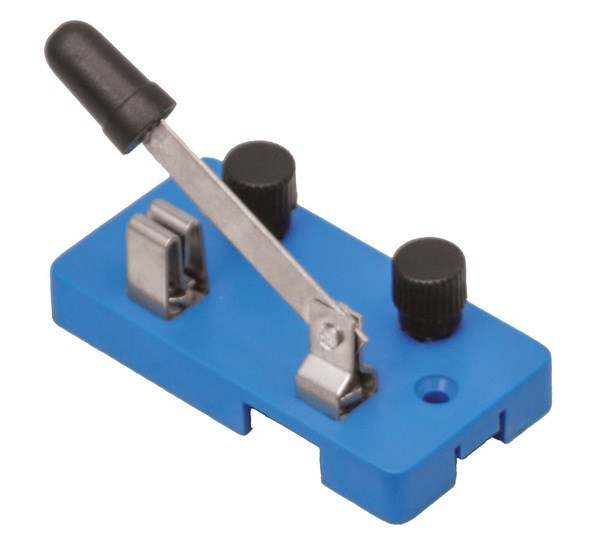Professionals and enthusiasts must comprehend electrical circuit components. Knife switches control electricity. This page will cover knife switches’ kinds, functions, and uses. Let’s learn about knife switches!
What is a Knife Switch?
Knife switches, also known as cutout switches or switchblade switches, regulate circuit current mechanically.
This device allows manual electrical connection activation and deactivation with a knife-like metal lever. The switch’s foundation is porcelain or Bakelite, while the lever is copper or brass.
The Anatomy of a Knife Switch

Each part of a knife switch has a purpose. Examine its anatomy:
Blade
The knife-like switch lever is the blade. Copper or brass are used because they conduct electricity well. Switch blades connect input and output terminals.
Handle
Handles allow users to manually manipulate switches. It controls the electrical connection by levering the blade.
Hinge
The switch hinge rotates the blade. Steel ensures smooth and stable operation.
Base
Knife switches have stable, insulated bases. To avoid electrical shocks and short circuits, it is made of porcelain or Bakelite.
Types of Knife Switches

Knife switches are made for different uses and environments. Explore some typical types:
One-Throw Knife Switch
Single throw knife switches are the simplest and most popular. Open and closed. Electrical current flows when the blade is closed. When the blade is open, the circuit breaks, preventing current flow.
Double-Throw Knife Switch
A double throw knife switch may switch two circuits at once. It can be open, closed to one terminal, or closed to both. This switch is typically used to regulate two circuits concurrently.
Fuse Knife Switch
Fuse-equipped knife switches exist. These switches include extra safety features to prevent overcurrents. When the current surpasses a threshold, the fuse melts, breaking the circuit.
Applications of Knife Switches

Knife switches are used widely. Some examples:
Educational Demonstrations: Knife switches are often used to teach electrical circuits. Teaching basic electrical principles is easy with their manual operation and obvious connection.
Industrial Machinery: Knife switches power heavy machinery in industrial environments. They make power interruption for maintenance or safety easy and reliable.
Scientific Experiments: Knife switches operate electrical circuits in labs. Scientists can manually control electricity flow rapidly and precisely.
Amateur Electronics: Hobbyist and DIY electronics enthusiasts like knife switches. They simplify electrical connection control in small projects and prototypes.
Historical Displays: Knife switches are used in museums and exhibitions to demonstrate electrical technology’s progression. They show the evolution of electrical systems.
Advantages of Knife Switches

Knife switches have various benefits that keep them in use. Advantages include:
Manual Control: Knife switches manually control electricity flow. Hands-on operation is easy.
Visible Connection: Knife switches’ open form lets users view the connection status. This visibility aids troubleshooting and circuit monitoring.
Durability: Knife switches can take a beating. Copper or brass blades and steel hinges assure durability.
Simplicity: Knife switches feature fewer parts than other switches. This simplicity simplifies use, maintenance, and repair.
Cost-Effective: Knife switches are cheaper than modern ones because of their simplicity and durability. They’re ideal for budget-conscious enterprises.
Knife Switch FAQ
Knife switches in current electrical systems?
Knife switches are still used in niche regions and historical displays.
High-voltage knife switches?
High-voltage knife switches are possible. Capacity depending on model and construction.
Knife switches: any safety concerns?
Before connecting or disconnecting knife switches, be sure the power is off. Avoid electrical risks by wearing PPE.
Knife switches for DC circuits?
AC and DC circuits can use knife switches. Current kind affects design and construction.
Replaceable knife switches?
Yes, replacing a knife switch is usually easy. Their design simplifies replacement.
Knife switches for automatic or remote control?
Knife switches are manual and lack automation or remote control. Other switches work better for such applications.
Conclusion
Knife switches are vital to electrical circuits despite their antiquated appearance. Their manual control, obvious connection, and longevity keep them relevant. Knife switches reliably manage electrical current in instructional demonstrations, industrial gear, and scientific studies.
Understanding their anatomy, types, and uses helps us appreciate these mechanical marvels. Next time you see a knife switch, you’ll know what it does.
Finally, a knife switch controls electrical current in a circuit. Its simplicity, manual operation, and apparent connection make it useful in many applications.
Knife switches are still used in some niches due to their historical relevance, durability, and cost-effectiveness. Knife switches have made significant contributions to electrical engineering.
